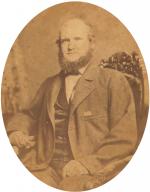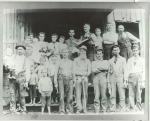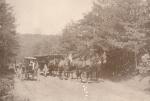![header=[Marker Text] body=[Built about 1837 to supply iron to Freedom Forge near Lewistown. Restored stack, the Church, Big House, and store common to iron making communities remain. Works closed 1904, the last to operate in this region ] sign](http://explorepahistory.com/kora/files/1/10/1-A-2B1-139-ExplorePAHistory-a0k1z0-a_450.jpg)
Mouse over for marker text
Name:
Greenwood Furnace
Region:
Laurel Highlands/Southern Alleghenies
County:
Huntingdon
Marker Location:
Pa. 305 at Greenwood Furnace State Park
Dedication Date:
April 4, 1947
Behind the Marker
Greenwood Furnace got off to a rough start in its early years, suffering through financial failures, but in the long run it operated successfully for an exceptionally long period.
A partnership of four men (Francis Rawle, James Hall, William Norris, and Samuel Patton), who also owned Freedom Iron Works in present-day Burnham, Mifflin County, began construction of Greenwood Furnace in 1832. Due to difficulty in finding building materials, however, the cold blast charcoal furnace did not go into blast until 1834. The furnace quickly foundered and went up for sale in 1835, along with Freedom Iron Works. Greenwood Furnace then passed through a series of owners and periods of idleness.
In 1849 John A. Wright and Company bought Greenwood Furnace and Freedom Iron Works, and ran the furnace more successfully. In 1850 Greenwood Furnace employed seventy-three men and produced 1,600 tons of pig iron. Freedom Iron Company took over Greenwood Furnace and the iron works in Burnham in 1856, and continued to expand production. By1860 Greenwood Furnace's annual production had grown to 1,800 tons of pig iron with employment of 140 men.
Like many other iron companies during the mid-nineteenth century, the Freedom Iron Company sought to lower production costs and increase output and efficiency. About 1866 it dismantled the cold blast furnace at Greenwood Furnace, robbing material from that furnace to build a new hot blast charcoal furnace next to the old site. With the operation of the new furnace, pig-iron production grew to more than 3,000 tons annually, making Greenwood Furnace the largest iron producer in Huntingdon County.
The Freedom Iron Company evolved into the Logan Steel and Iron Company, which continued to operate Greenwood Furnace. When Greenwood Furnace closed in 1904, it was the last of numerous Huntingdon County iron furnaces to go out of blast. Indeed, Greenwood Furnace ceased production only seventeen years before the end of the Eagle Ironworks, which was one of the last charcoal furnaces to close in the nation.
Eagle Ironworks, which was one of the last charcoal furnaces to close in the nation.
Production continued until 1904 in part because the owners adopted hot-blast technology. Securing closer sources of iron ore also helped the owners meet growing competition. Workers cleared vast tracts of forest around Greenwood Furnace for fuel, beginning close to the furnace and then spreading outwards.
Limestone came from various places in surrounding ridges or valleys. Iron ore, however, was the most expensive resource to transport to a charcoal furnace. At first, teamsters had to haul ore in wagons over the mountains from the Kishacoquillas Valley to the south. Later, the owners discovered ore deposits on Brush Ridge, just to the west of the furnace. Furnace workers built a three-mile-long tramway from the iron mines to the furnace. Mules pulled cars, each loaded with eleven tons of ore, along the tramway to the furnace.
The most important reason that Greenwood Furnace survived until 1904 was its integration into the iron and steel works in nearby Burnham. During its operating history, Greenwood Furnace sent the vast majority of its pig iron to the Burnham works. The Freedom Iron Company used Greenwood Furnace iron to make wheel rims for railroad locomotives. The Logan Steel and Iron Company continued transforming Greenwood Furnace iron into various products. As most other charcoal furnaces struggled to find markets and closed, Greenwood Furnace had the advantage of an almost guaranteed market in Burnham. The guarantee finally ran out in 1904 because other anthracite-coal and bituminous-coal furnaces could supply iron at lower cost.
In 1905 the Commonwealth of Pennsylvania acquired Greenwood Furnace and established a tree nursery, as part of the state's larger effort to reforest land denuded by iron furnaces and lumber companies. The state established Greenwood Furnace State Park in 1930. Today the park includes the reconstructed stack of the hot-blast furnace, the remains of the cold-blast furnace, an 1834 ironmaster's house, and an 1865 iron furnace church.
A partnership of four men (Francis Rawle, James Hall, William Norris, and Samuel Patton), who also owned Freedom Iron Works in present-day Burnham, Mifflin County, began construction of Greenwood Furnace in 1832. Due to difficulty in finding building materials, however, the cold blast charcoal furnace did not go into blast until 1834. The furnace quickly foundered and went up for sale in 1835, along with Freedom Iron Works. Greenwood Furnace then passed through a series of owners and periods of idleness.
In 1849 John A. Wright and Company bought Greenwood Furnace and Freedom Iron Works, and ran the furnace more successfully. In 1850 Greenwood Furnace employed seventy-three men and produced 1,600 tons of pig iron. Freedom Iron Company took over Greenwood Furnace and the iron works in Burnham in 1856, and continued to expand production. By1860 Greenwood Furnace's annual production had grown to 1,800 tons of pig iron with employment of 140 men.
Like many other iron companies during the mid-nineteenth century, the Freedom Iron Company sought to lower production costs and increase output and efficiency. About 1866 it dismantled the cold blast furnace at Greenwood Furnace, robbing material from that furnace to build a new hot blast charcoal furnace next to the old site. With the operation of the new furnace, pig-iron production grew to more than 3,000 tons annually, making Greenwood Furnace the largest iron producer in Huntingdon County.
The Freedom Iron Company evolved into the Logan Steel and Iron Company, which continued to operate Greenwood Furnace. When Greenwood Furnace closed in 1904, it was the last of numerous Huntingdon County iron furnaces to go out of blast. Indeed, Greenwood Furnace ceased production only seventeen years before the end of the
Production continued until 1904 in part because the owners adopted hot-blast technology. Securing closer sources of iron ore also helped the owners meet growing competition. Workers cleared vast tracts of forest around Greenwood Furnace for fuel, beginning close to the furnace and then spreading outwards.
Limestone came from various places in surrounding ridges or valleys. Iron ore, however, was the most expensive resource to transport to a charcoal furnace. At first, teamsters had to haul ore in wagons over the mountains from the Kishacoquillas Valley to the south. Later, the owners discovered ore deposits on Brush Ridge, just to the west of the furnace. Furnace workers built a three-mile-long tramway from the iron mines to the furnace. Mules pulled cars, each loaded with eleven tons of ore, along the tramway to the furnace.
The most important reason that Greenwood Furnace survived until 1904 was its integration into the iron and steel works in nearby Burnham. During its operating history, Greenwood Furnace sent the vast majority of its pig iron to the Burnham works. The Freedom Iron Company used Greenwood Furnace iron to make wheel rims for railroad locomotives. The Logan Steel and Iron Company continued transforming Greenwood Furnace iron into various products. As most other charcoal furnaces struggled to find markets and closed, Greenwood Furnace had the advantage of an almost guaranteed market in Burnham. The guarantee finally ran out in 1904 because other anthracite-coal and bituminous-coal furnaces could supply iron at lower cost.
In 1905 the Commonwealth of Pennsylvania acquired Greenwood Furnace and established a tree nursery, as part of the state's larger effort to reforest land denuded by iron furnaces and lumber companies. The state established Greenwood Furnace State Park in 1930. Today the park includes the reconstructed stack of the hot-blast furnace, the remains of the cold-blast furnace, an 1834 ironmaster's house, and an 1865 iron furnace church.
Beyond the Marker









![Various Greenwood furnace workers beside the "Brands Pile" at the furnace. This image has numbers next to the men in the photograph. They are as follows:1. Frank G. Kennedy, Supt. and Owner, Logan Iron and Steel Co., Philadelphia. 2. William Craig, Greenwood Furnace, Manager 3. Harvey Thompson, Asst. Manager and Wood Boss, (would become manager in 1903 after Craig left]. 4. G. Edward Ross, Ranger 5. James Singleton, Blacksmith 6. William Stringer, Asst. Blacksmith. 7. Grant Reed, wagonmaker, carpenter. 8. Henry Monsell, Charcoal Boss 9. James Gregory, Ore Weighmaster. 10. Samuel Barnes, Furnace elevator operator 11. Dan Barnes, laborer. 12. William Kephart, laborer Various Greenwood furnace workers beside the "Brands Pile" at the furnace. This image has numbers next to the men in the photograph. They are as follows:1. Frank G. Kennedy, Supt. and Owner, Logan Iron and Steel Co., Philadelphia. 2. William Craig, Greenwood Furnace, Manager 3. Harvey Thompson, Asst. Manager and Wood Boss, (would become manager in 1903 after Craig left]. 4. G. Edward Ross, Ranger 5. James Singleton, Blacksmith 6. William Stringer, Asst. Blacksmith. 7. Grant Reed, wagonmaker, carpenter. 8. Henry Monsell, Charcoal Boss 9. James Gregory, Ore Weighmaster. 10. Samuel Barnes, Furnace elevator operator 11. Dan Barnes, laborer. 12. William Kephart, laborer](http://cache.matrix.msu.edu/expa/small/1-2-100D-25-ExplorePAHistory-a0k5b4-a_349.jpg)
